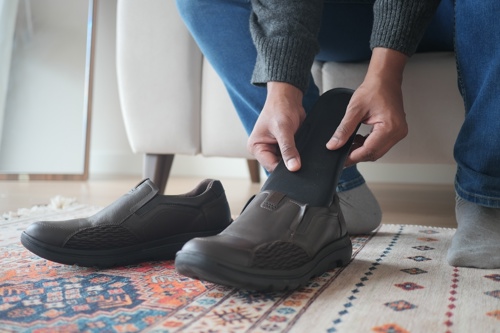Posterior Tibial Tendonitis: What You Need to Know

Living with a condition like posterior tibial tendonitis is not just frustrating; it can also be incredibly painful, especially when it starts affecting the daily activities we all take for granted, like exercising, walking, or even standing.
If left untreated, this inflammation or damage to the posterior tibial tendon can lead to arch collapse and long-term foot deformities. Therefore, understanding posterior tibial tendonitis is vital not just for prevention but also for effectively treating this condition. By recognizing the early warning signs and taking the appropriate measures, you can avoid more severe complications.
What Is Posterior Tibial Tendonitis?
Also known as tibialis posterior tendinopathy, posterior tibial tendonitis occurs when the posterior tibial tendon, which runs along the inside of the ankle and attaches to the arch of the foot, becomes inflamed, irritated, or torn.
This tendon is essential for maintaining proper foot alignment and stability. If the tendon weakens or tears over a period of time, it can lead to a collapsed arch, causing a condition known as progressive collapsing foot deformity (PCFD). With PCFD, you may experience progressive pain, swelling, and mobility problems.
Causes and Symptoms of Tendonitis
Several factors contribute to the development of posterior tibial tendonitis, including:
- Underlying medical conditions such as obesity, flat feet, and inflammatory conditions like rheumatoid arthritis
- Trauma or strain from an injury like twisting the ankle
- Overuse injuries through high-impact activities like tennis, basketball, or running, which place excessive strain on the tendon
- Aging and wear and tear, which make older individuals more susceptible
Posterior tibial tendonitis often develops gradually, with symptoms worsening over time. Common signs include:
- Pain and tenderness along the inside of the ankle and foot. Initially, discomfort may be mild and occur only after prolonged activity, but pain can become more frequent and constant, eventually becoming incapacitating. Tenderness is often felt behind and below the inside ankle bump.
- Swelling around the tendon, particularly near the ankle bone, where swelling may be visible along the path of the tendon from the back of the ankle across the inside of the foot. Additionally, a cracking sound may be heard when the tendon is moved or touched.
- Difficulty walking or standing for extended periods, with pain potentially worsening during or after activities like running, walking, and stair climbing. High-intensity or high-impact activities can be particularly difficult, and you may experience trouble standing for long periods.
- Progressive arch collapse, where the ankle may turn inward and the heel may shift outward. In advanced stages, standing on tiptoes or performing a single heel raise becomes challenging or impossible.
- Additional discomfort, such as stiffness or pain after rest (particularly in the morning) and pain on the outside of the ankle due to bone impingement.
Ways to Prevent Posterior Tibial Tendonitis
Although posterior tibial tendonitis can be painful and debilitating, there are effective ways to reduce the risk and protect your foot health:
Wear supportive shoes
Proper footwear is imperative for preventing tendon strain. Avoid unsupportive shoes like flip-flops, high heels, or worn-out sneakers, as they increase stress on the posterior tibial tendon. Instead, focus on shoes with good arch support, cushioned soles, and a firm heel counter.
Gradually increase your activity level
For anyone focused on fitness, overloading the tendon too quickly can lead to irritation and injury. Whether you're an established athlete or experimenting with a new exercise routine, gradually increasing intensity is key.
High-impact activities that involve repetitive landing should be done sparingly or with the correct form, allowing the body to adapt. If you enjoy running, consider incorporating lower-impact exercises like cycling or swimming to reduce strain on the feet. Also, be sure to schedule adequate rest days to allow the tendon time to recover.
Strengthen your foot and ankle
Several exercises can help maintain foot and ankle strength, including:
- Toe raises: Stand with your feet hip-width apart, lift your heels off the ground, then slowly lower them.
- Towel scrunches: Place a towel on the floor and use your toes to scrunch it toward you.
- Resistance exercises: Use a resistance band around the foot to perform controlled ankle movements, including dorsiflexion, plantar flexion, inversion, and eversion exercises to improve your ankle strength, stability, and range of motion.
Remember, always stop if you experience any pain, and work on quality over quantity.
Maintain a healthy weight
Excess body weight increases stress on the posterior tibial tendon, contributing to strain and potential injury. Maintaining a healthy weight through a balanced diet and regular exercise can reduce the risk of tendon-related issues.
How Our Podiatrists Can Help
If you are experiencing persistent foot or ankle pain, you may need to see a podiatrist. At Teton Foot and Ankle in Idaho Falls, we specialize in diagnosing and treating posterior tibial tendonitis. Our team will work with you to develop a treatment plan that will help you regain mobility and comfort.
Our podiatrists will assess your condition through a physical examination, checking for swelling, pain, and foot alignment. We also conduct imaging tests, such as ultrasounds and MRIs, to evaluate tendon damage and perform gait analysis to detect foot abnormalities.
In most cases, posterior tibial tendonitis can be managed with rest and ice therapy, physical therapy, and/or orthotic devices (such as specialized footwear).
In severe cases where conservative treatments fail, surgery may be necessary. At Teton Foot and Ankle, we perform procedures such as:
- Osteotomy, which involves realigning bones to restore proper foot structure
- Tendon repair or replacement
- Removing inflamed tissue from the tendon, also known as a tenosynovectomy
Our highly trained podiatrists are dedicated to providing the highest level of care to ensure the best outcomes for our patients.
Posterior Tibial Tendonitis Treatment in Idaho Falls
If you're struggling with posterior tibial tendonitis in Idaho Falls, early intervention is key to preventing long-term complications. Our specialists offer the latest and most effective treatment options tailored to your needs. Foot pain should never hold you back, so contact us today to schedule an appointment and start the recovery process.
Get in touch!
Call our office if you have any questions about what we do or to schedule an appointment.
